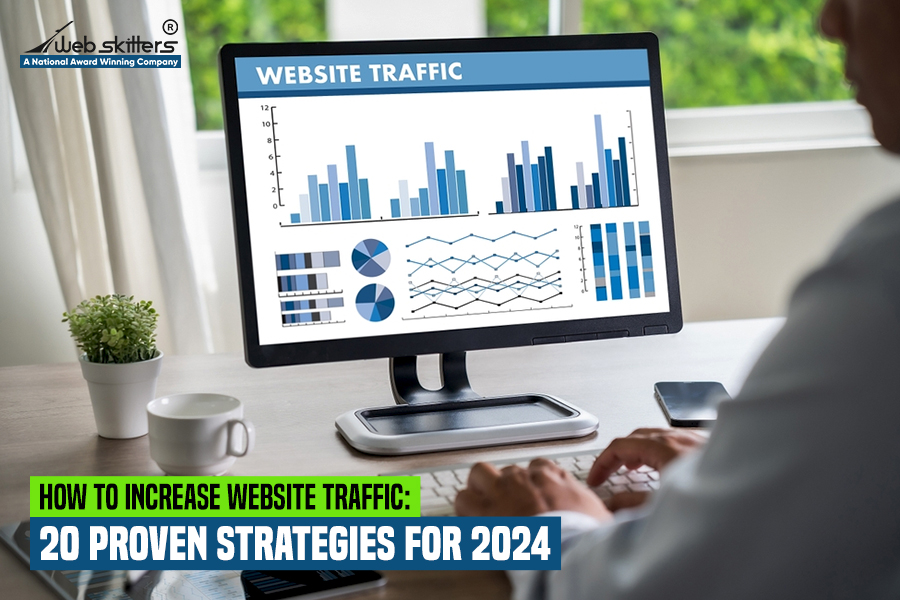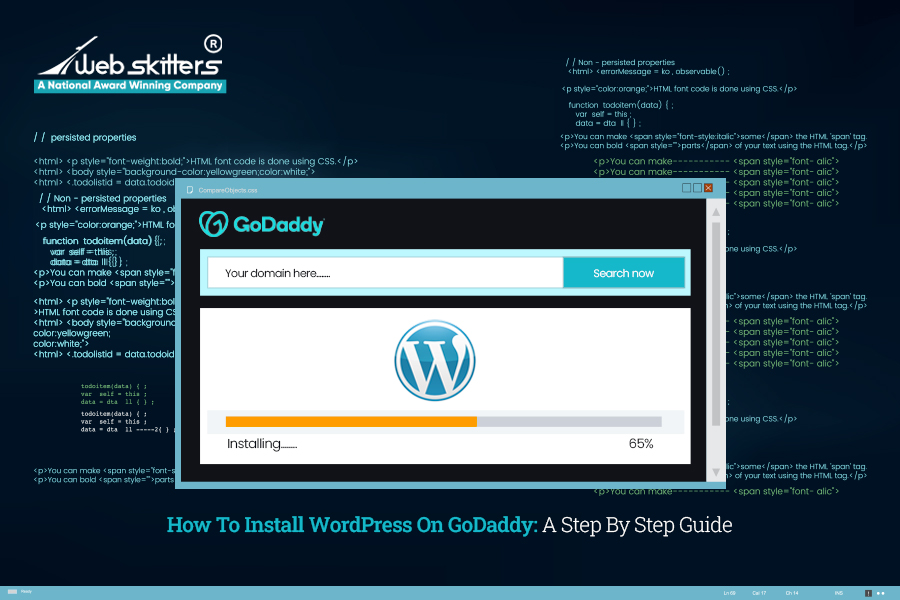Quality website traffic is the currency of the internet. It is the key to driving business growth, improving search engine credibility, measuring marketing efforts, gathering customer insights, and gaining more customers.
Yet, when you search for ‘how to increase website traffic,’ you will quickly realize there is more than one method to try.
According to a survey by BrightEdge, around 53% of website traffic comes through organic search. While it indicates the importance of investing in result-driven content and SEO strategies, it also means nearly half of the website traffic comes via several different sources, including social media and paid advertisement.
Considering the heavy traffic and frequent updates Google search engine results pages receive, it’s essential to take a holistic approach to bringing traffic to your website. You shall optimize all traffic sources equally to see your business at the top.
But where do you even begin with so many strategies to choose from?
To help you decide, we present an in-depth guide to the most effective strategies to increase website traffic in today’s blog. We explain how to execute these strategies and the tools you can use to achieve the best results. We also introduce key performance indicators.
So, open your notepad and delve into the below section now!
Overview Of The Importance Of Increasing Website Traffic
At its core, website traffic brings customers to your store, which translates to more revenue for the business. On top of that, you can use the data from traffic to determine whether your marketing efforts are bringing results.
However, to enjoy these benefits, you first need to learn about the different channels that bring traffic to your site.
Hence, here’s a sneak peek into the benefits of website traffic and the different traffic sources.
Why Is Increasing Website Traffic Essential for Businesses?
Website traffic allows you to gain valuable insights into the type of visitors you are receiving, what they are trying to achieve, and their customer journey. You can use all this information to turn your digital marketing strategies into more precise, result-driven plans.
Considering search engines love popular websites, the increased traffic will help your business rank on the first page of the search engine.
Need more reasons to invest in better website traffic? Look below!
1. Increased visibility
Higher traffic means your brand, services, and products will reach larger audience segments. The increased visibility will build brand awareness, establish your brand authority in the industry, and help you earn trust and credibility with your audience.
2. More lead generation, conversion, and sales
When your website receives high-quality traffic, it increases the chances of converting casual visitors into customers and leads. Each visitor is a potential customer. With the correct strategy, you could encourage them to purchase, engage with your content, or sign up for a newsletter. For e-commerce websites, high traffic can directly translate into more people browsing through your products and increased sales opportunities.
3. Gain customer insights
As previously mentioned, high traffic volumes offer more data on customer behavior, engagement, and preferences. Analyzing this data can help your business tailor their offerings, personalize content, enable targeted marketing strategies, enhance user experience, and boost website traffic even more.
4. Improved search engine rankings
Traffic volume and user engagement are two crucial indicators of a relevant and trustworthy website for a search engine. Higher traffic improves your website’s SEO rankings and creates a continuously increased traffic and conversion cycle. The more traffic your website receives, the more likely it will outperform competitors in SERPs.
5. Escalate advertising revenue
Advertisers are willing to pay more for advertising on sites with high traffic and visibility. The higher engagement of these pages helps them gain more clicks. At the same time, the site owner benefits from an additional revenue stream.
6. Community building and engagement
High traffic empowers brands to develop a community around them. They engage with this community through forums, comments, and social media to strengthen relationships, encourage word-of-mouth marketing, and build loyalty.
Different Sources Of Website Traffic
When strategizing to increase website traffic, it’s essential to tailor your strategy for individual traffic sources.
Now, you might wonder how many sources there are! While organic traffic is the most talked-about option, there are several other channels to drive traffic to your website.
Here are the top sources of website traffic at a glance:
- Organic search traffic refers to the organic search generated by visitors who find your business site or online store through search engines like Bing or Google.
- Direct traffic: This type of traffic comes from people who use your website’s URL to find your business online. For instance, someone may directly type or copy-paste the site’s URL into the search bar to reach your store.
- Referral traffic: Referral traffic is generated from visitors who click on your website’s link from another site. It usually occurs from backlinks or guest posting on another website.
- Social traffic: As the name suggests, social traffic comes from clicking on a link to your website from social media platforms such as Facebook and Instagram.
- Email traffic: Email traffic originates when people reach your website from a link mentioned in an email.
- Paid search traffic: Paid or sponsored search traffic stems from people clicking on an ad for your website on a search engine result page.
- Display traffic: Display traffic originates from people who view your website’s ads on apps or other websites.
You can use several apps to track and segment your website’s generated traffic, such as Google Analytics, Ahrefs, Moz, Semrush, and SimilarWeb. Once you identify your website’s most relevant traffic sources, you can prioritize them in your marketing strategies and potentially gain more customers.
Explanation of Strategies for Each Traffic Source
Any business with an online presence needs traffic. Without traffic, you will not have an audience to cater to, which will result in a lack of revenue. Therefore, traffic is crucial.
Now, countless elements impact a website’s traffic. Some factors are within your influence, while others are beyond it. For instance, you can improve your website’s content quality and speed to perform better in search engine results. You can even widen your content distribution to reach more people. However, you cannot influence the frequent search engine and social media algorithm updates, the introduction of disruptive technology like AI, and fluctuations in your customers’ interests.
Keeping in mind the factors you can influence, here are the 20 most effective ways to increase website traffic:
1. Understand your audience and cultivate engagement
Clearly defined audience segmentations lie at the heart of every successful digital marketing strategy that brings quality traffic. Defining your audience is not just about knowing their demographics. You also need to know their motivations, aspirations, and pain points.
So, how do customer identification and segmentation work?
There are several strategies, but the most common ones include:
- Surveys: Ask your potential and current customers about their psychographics, demographics, and behavioral characteristics.
- Focus groups: Bring together a small group of people containing your targeted audience to discuss their interests and needs.
- Customer personas: Identify your target audience using fictional representations of your ideal customers.
- Web analytics: Use analytics tools, CRM data, social media information, and other software to track the demographics, behavioral characteristics, and psychographics of your targeted audience and website visitors.
Once you gather the data, create adequate user personas, analyze user behavior, monitor and engage with your audience, and analyze customer feedback to identify and segment your targeted audience.
2. Search Engine Optimization
B2B businesses generate twice as much profit from organic search traffic as other sources. Understandably, among all the ways to enhance website traffic, the strategies to boost organic search remain the most popular for businesses.
Search engine optimization or SEO ensures your business website ranks higher on a SERP or search engine result page. It increases your website’s visibility, so you receive more traffic.
A good SEO strategy aims to consistently rank on the first search engine result page for search terms or keywords related to your business and target audience.
Considering the first page of Google searches captures 71% of search traffic clicks, SEO is crucial for organically growing website traffic.
Here are three aspects of effective SEO strategies.
- Careful use of keywords
- Link building
- High-quality content
Additionally, remember that there are different types of SEO, including On-page, off-page, technical, and local SEO. To get the best results from your SEO campaigns, you must utilize all forms of search engine optimization strategy.
3. Generate direct traffic
Direct traffic represents visitors who intentionally type your website’s URL into a browser or bookmark your site. Unlike organic traffic, direct traffic methods for improving website traffic signify a solid online reputation, user loyalty, and brand recognition.
However, increasing direct traffic requires an in-depth understanding of your audience and a thoughtful strategic approach.
If you don’t have a big brand name, ask yourself how your targeted customers can find your website’s URL or why they would bookmark it.
The answer is usually effective marketing campaigns and quality content.
Well-executed advertisements or events that include references to your website URL can boost direct traffic.
Direct traffic visitors often include
- Returning customers or visitors
- Visitors redirected by word-of-mouth
- Visitors that may have interacted with your offline campaigns
4. Content marketing
Besides being a key part of SEO strategies to increase website traffic, content marketing has become one of the most effective ways to attract organic traffic to a website. According to Forbes, 76% of B2B businesses found content marketing highly effective for generating leads.
Long-form, SEO-optimized content ranks well on search engine result pages. You can use it to answer the queries of your targeted customers and lead them to your website. Furthermore, high-quality, authentic content can help establish your authority in the field, aiding you in building trust and credibility with potential customers.
Furthermore, when visitors share your content on social media and other platforms, it boosts your company’s reach and drives new visitors to your site.
Content marketing also fuels paid advertisements and email marketing campaigns, keeping your website at the forefront of your audience’s mind.
5. Influencer marketing
Emerging as one of the most popular forms of paid search traffic and shared among the tips for boosting website traffic, influencer marketing involves partnering with social media influencers to promote your services or products.
This marketing strategy allows you to tap into a broader audience through the influencer’s followers. It helps ensure your targeted audience that your brand is genuine and encourages them to visit your online store, browse products/services, and purchase.
When partnering with influencers, be sure to find people with an engaged following that is relevant to your target audience. Once you have found an ideal influencer, partner with them to create relevant content and track your campaigns.
6. Newsletter and email marketing
Whether you use Microsoft, Google, or another email platform, you can use it to stem email traffic.
Email traffic, one of the most effective strategies for increasing website traffic, indicates the number of visitors arriving at your website after clicking a link in an email you sent them. It’s an excellent strategy for driving traffic to a website, specifically for a customer segment that has shown some interest in your brand.
You can personalize the emails to target different customer segments, inform customers about ongoing sales, recent deals, and new products/services, and share your content. Regularly sending emails and newsletters helps nurture leads and establish stronger relationships. It will also enable you to easily track open rates, click-through rates, and conversion rates.
7. Social media marketing
If you want to know how to increase website traffic effortlessly, social media is your answer.
Social media platforms present paid and non-paid ways to promote your brand and generate social traffic.
You can use texts, infographics, videos, and images to boost engagement with your audience. This will keep your brand always in front of potential customers and drive new visitors to your site.
Like email traffic, you can personalize your social media content based on audience interests and demographics, resulting in quality traffic. Social media also makes it much easier for your audience to share your content, which can potentially go viral and drive significant website traffic quickly. Additionally, social media marketing enables you to enjoy two-way communication and use multiple traffic channels to target specific audiences.
8. Voice search optimization
Do you know voice searches account for over 1 billion searches per month?
As more people use voice assistants like Siri, Google Assistant, and Alexa, optimizing your website for voice searches has become critical.
It can help increase your website’s organic traffic, get ahead of your competitors, and enable your brand to reach more people.
Here are a few things to remember to optimize your website for voice search and enhance website visibility:
- Answer-focused content: Create content that answers your customers’ most commonly asked questions.
- Long-tail keywords: Focus on long-tail keywords to optimize your content for voice search.
- Optimize for snippets: Include short, precise answers into your content to appear in the snippets of SERP.
9. Video Marketing
Videos are engaging, easily shareable, and make it incredibly easy to deliver your message to the audience. As a method of display marketing, you can use platforms such as Facebook, Instagram, and YouTube to advertise your brand through video content.
Keeping in mind that 77% of young internet users (between 15-35 years of age) use YouTube to consume video content, video marketing can effectively generate more website visits.
10. Quality Backlinks
Backlinks or inbound links are among the most popular ways to gain referral traffic for your website. It helps you earn votes of confidence from other websites, which signals search engines about the importance and trustworthiness of your content.
An effective backlink strategy involves linking your website with the content of other websites. It enables you to benefit from another website’s traffic by bringing it to your website.
Backlinks can help you generate exceptional results when done right.
11. Paid Ads
All paid ads are highly effective strategies for attracting website visitors, from search ads or sponsored websites on SERP to banner and display ads. Due to their clever position, they are quick to attract the glare of your target audience.
Furthermore, there are many platforms for displaying paid advertisements on your website, including Google Ads and social media sites like Facebook and Instagram.
You will simply personalize your advertisements based on the needs of your targeted audience, pay for the platform, and enjoy the increased audience.
12. Engage with the community
The more brand recognition your company earns, the more website traffic you will receive.
One way to achieve brand recognition and identity is by regularly engaging with your targeted audience.
You can do this through live chats, group discussions, content, Q&A sessions, meet-and-greet events, and replying to your visitors’ comments.
A key thing to remember when engaging with your audience is staying genuine, empathetic, and helpful instead of pushing your brand on them.
13. Offer a seamless user experience
Around 88% of users are unlikely to revisit a website where they have had a bad experience. Search engines also prefer websites that provide users with a good experience when listing the search results.
So, to increase web traffic effectively, ensure your website is
- Fast to load
- Accessible to everyone
- Easy to navigate
- Simple to understand and read
- Responsive
14. Media coverage
Another way to gain paid traffic is media coverage. With the help of a good PR team, you can create word of mouth through advertising on various platforms. It will help you earn third-party validation for your business, enable you to communicate your company’s products, offers, culture, events, and other aspects with the targeted audience, and enhance website traffic.
15. Easy to find domain
Select an easy-to-find domain name and create, maintain, and update your business profile and listings on different directories, websites, search engines, and social media platforms.
It will help you maintain the accuracy and consistency of your website content while improving your online visibility. Listing management will act as a part of the referral traffic strategy and build customer trust.
16. Optimize landing pages and CTR
Optimize your website’s landing page with engaging, keyword-rich, and tailored content. Ensure when your visitors reach the landing page, it instantly grabs their attention with the services and products they are looking for.
Additionally, you can create personalized messages and tags and include them in your marketing campaign for contacts.
Also, utilize click-through rate or CTR to measure the number of people clicking through your content. You can use Google Search Console for this. Incorporate the statistics in your traffic generation tactics to drive more traffic, and write compelling meta descriptions and titles.
17. Use native channels
Native advertising refers to the type of advertising where the form of a piece of content or paid ad matches the media format. The advantage of using native channels for website traffic optimization is that your messaging is not automatically perceived as promotional.
For instance, platforms like LinkedIn and Medium have publishing options that allow you to create content native to the platform. Lots of businesses use these avenues to generate paid and referral traffic.
18. Image search
The image search tab on Google is another way to generate paid traffic. Include videos, images, and infographics in your content to appear on the search engine result page for image searches. Be sure to optimize the content with adequate keywords and descriptions. You will soon notice a significant increase in your website traffic.
The visual content will also encourage your visitors to stay on your website longer, reducing the chances of a bounce rate.
19. Keywords
Optimizing website content with relevant keywords is among the best SEO practices and traffic-building strategies for generating organic traffic.
Through free tools like the Google Search Console or Google Analytics, you can find the most common search terms related to your services/products and include them in your content to make your website more accessible to find for search engines and visitors. You can identify the keywords that drive the most traffic and use them to optimize content headings, meta descriptions, titles, content, and headers.
20. Website Analysis
To monitor your website’s performance, learn the significance of consistent website analysis. This will help you understand your audience, including their needs, purchasing patterns, preferences, and search behavior.
Furthermore, using analytics, you can identify your website’s strengths and weaknesses and improve its flaws. The analysis’s outcome will help you create well-structured, optimized content, improve your organic traffic rate, and enhance your website traffic growth methods.
How to Implement the Strategies?
If you wish to grow your business via your website, only knowing the above strategies is insufficient.
You must know how to correctly execute these strategies to be found by your visitors and search engines. Proper execution is necessary for increased growth, sales, and engagement.
Thus, here, we are presenting a few tips and highlighting easy-to-use tools that will help you execute the top strategies for increased website traffic.
1. Create user personas to understand your ideal audience
If you want to identify the characteristics of your targeted audience, an excellent place to start the process is creating user personas.
The data from user personas will help form your marketing content, target the correct keywords, and ensure your efforts align with user intent.
Furthermore, based on your user persona, you will analyze your customers’ behavior, focusing on how they interact with your website and what content interests them.
There are several ways to analyze user behavior, including the following:
- Web analytics
- Heatmaps
- A/B testing
- Bounce rates
- Click patterns
- Session duration
After grasping user behavior, you can use social media platforms to engage with your audience by sharing content, responding to comments, analyzing content, and participating in discussions.
We suggest BuzzSumo, Audience, and Meltwater as tools for gaining audience insights. Be sure to use multiple sources of information to avoid dealing with inaccurate data.
Additionally, analyze the feedback gathered from customer support and sales to tailor your marketing and content strategies. You can use CRM data to identify
- Aspects of outdated marketing personas
- Gaps in audience understanding of services and products
- Pain points that you’re not currently addressing
2. Strategically place keywords to improve SEO rankings
Your content’s lack of relevant keywords will make it invisible to search engines. So, if you want to increase website traffic, identify phrases and queries pertinent to your targeted audience. Focus on short-tail, mid-tail, and long-tail keywords.
A few tools you can use for your keyword research are:
- Semrush
- Ahrefs
- Moz keyword explorer
- Google keyword planner
- Keywords Everywhere
3. Use content marketing strategies for more organic traffic
According to HubSpot’s State of Marketing report, high-quality content, including website and social content, is virtually tied to influencer marketing to bring the highest return on investment to any marketing channel.
Content is one of the cornerstones of organic traffic, so you must prioritize creating content that’s accurate and relevant to your audience.
Here are a few tips to help you create content that stands out and understand how to increase website traffic:
- Be consistent with the content quality
- Create dynamic content featuring custom visuals, videos, infographics, and web tools
- Write long-form content
- Repurpose old content
- Include relevant keywords as per Google’s criteria
4. Tips to implement a backlink strategy
There are several ways to gain referral traffic through backlinks. While these strategies can be time-consuming, they are highly beneficial in the long haul, particularly for standing out to search engines.
Here’s what you can do to execute a successful backlink strategy:
- Submit your website to multiple online directories
- Guest post on high-authority websites to gain exposure
- Share your website’s link to social media through engaging and shareable content
- Participate in online forums
- Focus on internal link building
5. Prioritize on-page SEO
On-page SEO refers to optimizing individual pages of a website to rank higher in search engines and attract more organic traffic.
Some of the most critical aspects of on-page SEO include:
- Incorporating relevant keywords
- Optimizing title tags and meta descriptions
- Creating high-quality content
- Internal linking
- Optimized images
- Mobile-friendly, secure websites
You can use tools like Moz, Semrush, Yoast, and Frase.io to perfect your on-page SEO strategies to increase website traffic.
6. Off-page SEO
Off-page SEO means taking action outside your website to influence SERP rankings and stem organic traffic.
The key pillars of off-page SEO include:
- Receiving backlinks from other sites
- Driving traffic through social media
- Leverage influencer marketing
- Guest posting on reputed websites
7. Technical SEO
Technical SEO refers to the process of optimizing your website to improve organic traffic and increase exposure to search engines.
Technical SEO includes:
- Mobile-friendliness
- Using a sitemap
- URL format and structure
- Security
- Page loading speed
We recommend using Google Search Console and PageSpeed insights to identify improvement opportunities in your website.
8. Local SEO
Google uses social media profile pages, links, local content, and citations to discover nearby businesses and recommend them when a user searches for a product or service with their location.
So, if you wish to appeal to your local consumers, be sure to
- Create a Google My Business profile
- Use location-based keywords on your website
- Utilize directory management tools to monitor directories
9. Get listed in online directories
In addition to creating a Google My Business profile, list your business and continuously update it on industry-specific directories, Bing places, and broad directories, including
- Better Business Bureau
- Yelp
- Yellow Pages
10. Invite guest bloggers to your website
Have industry leaders or expert writers write guest posts on your website. It will help your brand build credibility, drive organic and referral traffic, and stimulate influencer marketing.
Another way to do this is to ask industry leaders and influencers to mention your business in a review or post. This type of collaboration can benefit both parties.
Measuring Success
A good website-traffic enhancing strategy is about following plans and ensuring the executions are bringing visible results.
Setting key performance indicators (KPIs) and measuring whether your marketing strategies are reaching those goals is the only way to understand how you can better tailor your website, content, and user experience to drive conversions.
By measuring the success of your marketing plan, you can track progress, identify areas of improvement, increase ROI, and make data-driven decisions.
So, what do the KPIs for increasing website traffic look like?
Here are a few examples to help you understand:
- Conversion rate
- Bounce rate
- Average time on page
- Return visitor rate
Once you set your goals, you can use Google Analytics, Search Console, Clicky, Hotjar, Crazy Egg, Adobe Analytics, and Similar Web to measure your progress and adjust the KPIs accordingly.
Conclusion
While these are the best strategies for increasing website traffic, remember there is no one-size-fits-all approach. Expect to invest considerable time and make several mistakes before finding methods that work for your business and audience.
Once you find what applies to your services, constantly improve your plans and track your numbers while keeping pace with the market trend.
Furthermore, if you are a new business owner, we recommend starting with free traffic-building strategies, such as organic, email, or referral traffic. Once you establish a name, you can move on to paid advertisement, social media marketing, influencer marketing, and others.
If you have any further queries regarding increasing website traffic or digital marketing, contact Webskitters Technology Solutions Pvt. Ltd. We have helped hundreds of medium enterprises build a successful online presence with our data-driven digital marketing solution. We have the perfect solution for you regardless of the scare or type of exposure you need online. So, connect with us today!


 May 28, 2024
May 28, 2024 








